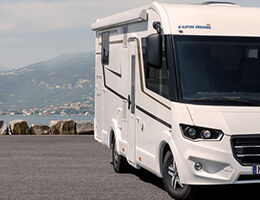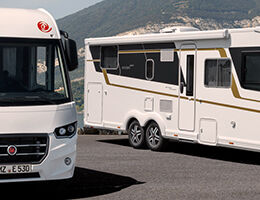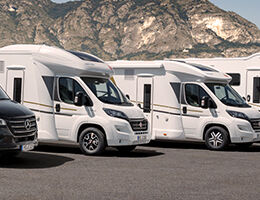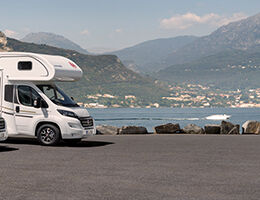Disclaimer
Please note: The prices stated on this website include 19% VAT and apply to vehicles with incoming orders and deliveries by January 01, 2021 and are valid only for Germany. All information on this webpage are without guarantee. The models illustrated on this webpage show the features available in Germany. They may also contain special equipment options and accessories that are not included with the standard scope of delivery. Due to legal regulations, differences from the model variations described here and equipment featured may be necessary in certain countries. Please ask your Eura Mobil dealer about the exact scope and range available of model-specific and model-neutral features. Subject to errors and changes in design, equipment and special features.
Important information regarding vehicle weights
Since each vehicle in drive mode is only permitted to exhibit an overall weight defined by the manufacturer, weight-related specifications are particularly important when purchasing a motor home or van. This is especially true when choosing packages and special equipment that is installed at the factory. It must be kept in mind that the overall weight permitted in road traffic may never be exceeded while driving.
The information below is therefore intended to make configuring your vehicle easier and explain the legal requirements relating to vehicle weights. Please read this information through carefully before starting your vehicle configuration process and contact your dealer if you have any questions.
-
The technically permissible overall weight
The technically permissible overall weight in a laden state can be found in the technical data for our motor homes and vans, as well as in the configurator. This figure represents the overall weight defined by the manufacturer that the vehicle must not exceed while driving. Otherwise, in many European countries, including Germany, fines may be issued. Since you as the driver of the vehicle are responsible for complying with the technically permissible overall weight, we recommend that you check your vehicle before every journey and weigh your vehicle before setting off.
-
Weight in ready-to-drive state
The weight in ready-to-drive state refers to the weight of the vehicle (with standard features according to the manufacturer’s specifications) with its fuel tank filled to at least 90% of capacity and includes the weight of the driver (which is calculated at a nominal value of 75 kg), the weight of the fuel and fluids, the weight of the superstructure and the driver’s cab, and the weight of the towing hitch and the tyre repair kit (to the extent these are present).
Information regarding the weight in the ready-to-drive state can also be found in the technical data for our motor homes and vans, as well as in our configurator.
It is important to note that the weight in ready-to-drive state is a value calculated in the type approval procedure, which is subject to legally permissible fluctuations of up to +/- 5%.
Since these fluctuations impact the remaining payload of the individual vehicle, the occurrence of legally permissible fluctuations must be factored in during the configuration and selection of packages and special equipment.
Example: In the technical data, the weight in the ready-to-drive state for the floor plan you have chosen is stated as 2,910 kg. This calculated value is subject to legally permissible fluctuations of +/- 5%, i.e. +/- 146 kg. The weight in ready-to-drive state of the individual vehicle can therefore range from 2,764 kg to 3,056 kg.
We also list the legally permissible fluctuations in the technical data for our motor homes and vans, as well as in our configurator as an additional text in brackets.
-
The weight of the passengers
The weight of the passengers is calculated from the number of belt-restrained seats defined by the manufacturer and is set at a nominal 75 kg per seat, whereas the weight of the driver, which was already taken into account in the weight in the ready-to-drive state, must be deducted. In the case of a vehicle with four belt-restrained seats, the weight of the passengers is therefore 225 kg (3 x 75 kg).
The number of belt-restrained seats can be found in the technical data for our motor homes and vans, as well as in our configurator. Please note that these numbers represent the highest possible number of belt-restrained seats for the series-version floor plan in question. The number of belt-restrained seats can however be reduced by the selection of packages and special equipment, or make an increase in the vehicle’s load capacity necessary.
-
The actual weight of the vehicle | Packages and special equipment
The actual weight of the vehicle refers to the weight of the vehicle in the ready-to-drive state plus the packages or special equipment installed at the factory and is listed under point 13.2 of the certificate of conformity (CoC). This figure does not include the special equipment or other accessories that are added by a retailer or by you personally after delivery of the vehicle from the factory.
It should be noted that the actual weight of the vehicle is also a calculated value, which may deviate from a value determined for your individual vehicle due to legally permissible fluctuations in the weight in ready-to-drive state as a calculated value of the actual vehicle weight.
Information regarding the weights of the packages and special equipment available ex works for our motor homes and vans can be found in our configurator and in the technical data.
-
Payload and minimum payload
The payload is the maximum load that a vehicle can carry and is calculated by subtracting the weight in ready-to-drive state, the weight of the passengers and the weight of the packages and special equipment fitted ex works from the technically permissible overall weight.
Example:
| Designation | Weight in kg |
|---|---|
| Technically permissible overall weight | 3.500 |
| Weight in ready-to-drive state | – 2.910 |
| Weight of the passengers | – 225 (3*75) |
| Weight of the packages / special equipment | – 100 |
| Payload | = 265 |
The installation of packages and special equipment will accordingly always lead to a reduction in the payload. The maximum weights available for packages and special equipment for each floor plan are shown separately in the technical data for our motor homes and vans and in our configurator.
For motor homes and vans as Class M1 vehicles, compliance with a minimum payload, i.e. the minimum load that a vehicle can transport, is required by law. This minimum payload must not be undercut either when configuring a vehicle or during production and is calculated for our motor homes and vans according to the following formula:
Minimum payload in kg ≥ 10*(n + L)
Where: “n” is the maximum number of belt-restrained seats, plus the vehicle driver, and “L” is the total length of the vehicle in metres.
Example: In the case of a motor home with 4 belt-restrained seats and a length of 7 m, the minimum payload is 110 kg (10 x [4+7]).
It is important to note that legally permissible fluctuations in the weight in ready-to-drive state can increase the payload of the individual vehicle, but can also reduce it.
| Designation | Weight in kg |
|---|---|
| Technically permissible overall weight | 3.500 |
| Weight in ready-to-drive state (+ 4 %) | – 3.026,4 |
| Weight of the passengers | – 225 (3*75) |
| Weight of the packages / special equipment | – 100 |
| Payload | = 148,6 |
In order to prevent such fluctuations from leading to a shortfall in the legally prescribed minimum payload, we have limited the maximum weight for packages and special equipment on the manufacturer’s side based on the legally permissible fluctuations. Information regarding this can be found in the technical data for our motor homes and vans, as well as in our configurator. This data also takes into account special equipment features of country variations / special models that do not form part of the series equipment.
If the configuration process for our motor homes and vans leads to the upper limit for this as defined by the manufacturer being exceeded as a result of the choice of packages and special equipment, you can only continue with the configuration process if you de-select packages, special equipment or belt-restrained seats or choose to increase the vehicle’s load capacity. Otherwise, you will not be able to configure or ordering the configured vehicle.
In exceptional cases, despite a restriction of the weights for packages and special equipment, weighing at the end of the production line can reveal that the individual vehicle’s minimum payload is undercut due to legally permissible fluctuations. In such cases, we will not ship the vehicle in question before compliance with the minimum payload is ensured through the removal of packages, special equipment or belt-restrained seats or the vehicle’s load capacity is increased.






